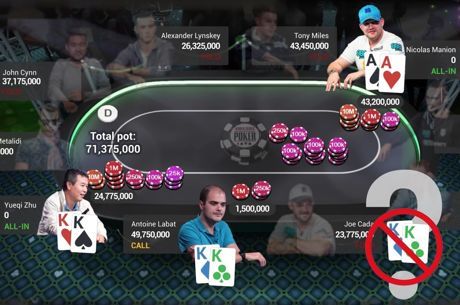Exploring Short Deck Hold'em, Part 4: Postflop Play

Table Of Contents
If preflop play in traditional Texas hold'em is checkers, then postflop plays definitely becomes chess.
Anyone can play a couple of aces preflop, but things get much trickier once the community cards start hitting the felt. How are you going to tread with A♣A♠ once the J♦10♦7♣ flop hits? It isn't completely clear what the best line is, as how you proceed often depends upon variables like stack sizes, position, and opponents who are constantly changing.
And that's just on the flop. Things become infinitely more complicated on the turn and river, not to mention more important as the pot gets bigger and mistakes become more costly.
Short deck hold'em might have only 36 cards, but many of the same principles apply. Postflop play is going to be a deeper, more complex thought process compared to preflop, where equities run pretty close, as Part 2 of this series outlined.
In the last installment, we went over some guidelines for preflop play in short deck, with none other than the great Isaac Haxton offering up some thoughts. This week, Jason Somerville speaks to PokerNews about postflop play.
Thinking About Ranges
One of the things Haxton mentioned in discussing the transition to short deck from traditional hold'em is the need to recalibrate our mental perception of some of the cards and hands. In his example, he pointed out that you must register 7♥6♥ as 3♥2♥ and realize this hand is terrible.
Similarly, postflop ranges have to be mentally recalibrated, particularly in heads-up pots.
For example, Somerville suggests thinking about which flops you're continuation betting as the preflop raiser. In hold'em, you'd likely bet often on a 2x2xJx flop if you open preflop and get one caller. In the same vein, if the flop comes 6x6xJx in short deck, that's essentially the same situation.
"That's a very good flop heads up as the preflop raiser," Somerville says.
Continuation betting in general, he says, follows a similar line to hold'em. It's not as common simply because preflop raises aren't as common as in hold'em, so there are more limped pots. Consequently, one player doesn't have the betting lead going into the flop as often.
"There are a lot of similar boards you'd want to be betting," Somerville says of continuation betting postflop, while cautioning that the reverse is true as well: know your opponents' ranges.
"Similarly, 6x6x7x under the gun versus button, button is way more likely to have a six or seven than you are," he continues. "Understand what kind of boards hit you and what kind of ranges your opponents have."
Overall, Somerville feels it's actually a little easier to range your opponents in short deck compared to no-limit for the simple reason that there are fewer cards in the deck. The complicating factor, of course, is all of the multi-way pots.
Operating in Multi-Way Pots
As we established in looking at preflop play, it's frequently correct for players to limp into the pot in short deck. From a mathematical perspective, the first player to act is getting something like 8-to-1 on his or her money to put in one more ante to see the flop. Obviously, a raise behind would change things, but that's still an attractive price in a game where many hands are playable.
Thus, heads-up pots are relatively rare in short deck (where players tend to see lots of flops) when compared to no-limit hold'em games (where players should be folding the vast majority of their hands).
"So many people see flops [in short deck], the decision trees are harder to solve than no-limit," Somerville says. "That makes short deck more complicated."
As an example, he points out, think of the most "traditional" sort of hold'em pot.
"Button raises, big blind calls," Somerville said. "We as veterans of the game can figure out these ranges. These are the hands you should have."
Contrast that to a common short deck situation — e.g., four limpers see a Jx8x6x flop.
"Who of the four limpers has the strongest range here?" Somerville asks. "It's not necessarily nearly as clear."
This creates many difficult situations postflop. Somerville believes that makes short deck a more complex, interesting game than many might give it credit for if their only exposure is seeing preflop shovefests in tournaments and knowing how close equities run.
Next week, Somerville will expand with some thoughts on bet sizing, position, and playing later streets.
In this Series
- 1 Short Deck Poker Rules: How to Play Short Deck Poker
- 2 Exploring Short Deck Hold'em, Part 2: Odds and Probabilities
- 3 Exploring Short Deck Hold'em, Part 3: Preflop Play
- 4 Exploring Short Deck Hold'em, Part 4: Postflop Play
- 5 Exploring Short Deck Hold'em, Part 5: Postflop Play Continued
- 6 Exploring Short Deck Hold'em, Part 6: Hand Review - Bonomo Bluffs
- 7 Exploring Short Deck Hold'em, Part 7: Hand Review - Ivey Shoves Big
- 8 Exploring Short Deck Hold'em, Part 8: Hand Review - Koon Uses Blockers
- 9 Exploring Short Deck Hold'em, Part 9: Hand Review - Yu Finds a Fold
- 10 Exploring Short Deck Hold'em, Part 10: Tournaments and the Future









